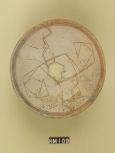Pottery
 The term black-on-white refers to the pottery design hues created by varying firing temperatures in the kiln. The Mimbres’ use of the white negative space in their pottery designs accentuates the range of oranges, browns, and blacks that make up the actual design. Mimbres pottery was made using the coil technique and featured hemispherical bowls about 10 inches across and 5 inches deep. Based on traditions of the southwestern Pueblo people of today, it is assumed that the artists of the pots were women. The surface of the outside of the bowls varied widely from that of the inside; while the outside was rough and undecorated, the inside was burnished to produce a smooth finish, slipped (coated with a thin layer of white clay), and then painted. In fact, as Mimbres pottery expert J. J. Brody suggests, the attention paid to the insides of the bowl rather than to the shape and outside appearance of the pottery, implies that the vessels were considered less as containers than as surfaces to paint upon.
The term black-on-white refers to the pottery design hues created by varying firing temperatures in the kiln. The Mimbres’ use of the white negative space in their pottery designs accentuates the range of oranges, browns, and blacks that make up the actual design. Mimbres pottery was made using the coil technique and featured hemispherical bowls about 10 inches across and 5 inches deep. Based on traditions of the southwestern Pueblo people of today, it is assumed that the artists of the pots were women. The surface of the outside of the bowls varied widely from that of the inside; while the outside was rough and undecorated, the inside was burnished to produce a smooth finish, slipped (coated with a thin layer of white clay), and then painted. In fact, as Mimbres pottery expert J. J. Brody suggests, the attention paid to the insides of the bowl rather than to the shape and outside appearance of the pottery, implies that the vessels were considered less as containers than as surfaces to paint upon.
The earliest Mimbres pottery tended to be plain brown, gourd-shaped, undecorated utilitarian wares. Between A.D. 200 and A.D. 550 attempts were made to perfect a red finish as well as a brown. As a result, pots were finished in a range of reds and browns until A.D. 550, when the Mimbres finally perfected the red pottery. Beginning around A.D. 650, Mimbres pottery was decorated with painted geometric designs (HM 102, 109) that covered the entire interior of the bowls. These geometric designs became more complex as the composition of the bowls was later divided to emphasize negative space. Stylized animal figures appeared on the bowls around A.D. 750, and human figures followed around A.D. 1000. The Palmer Collection is made up of pottery from the animal and human figural stage of Mimbres Pottery, dating from about A.D. 1000 to the end of Mimbres civilization at about A.D. 1250. The designs and figures painted on the bowls were painted on using a yucca brush—a brush made from the fibrous yucca leaf. The brush was probably softened by chewing and then trimmed into a square tip that would create solid lines across the contours of the bowl.
